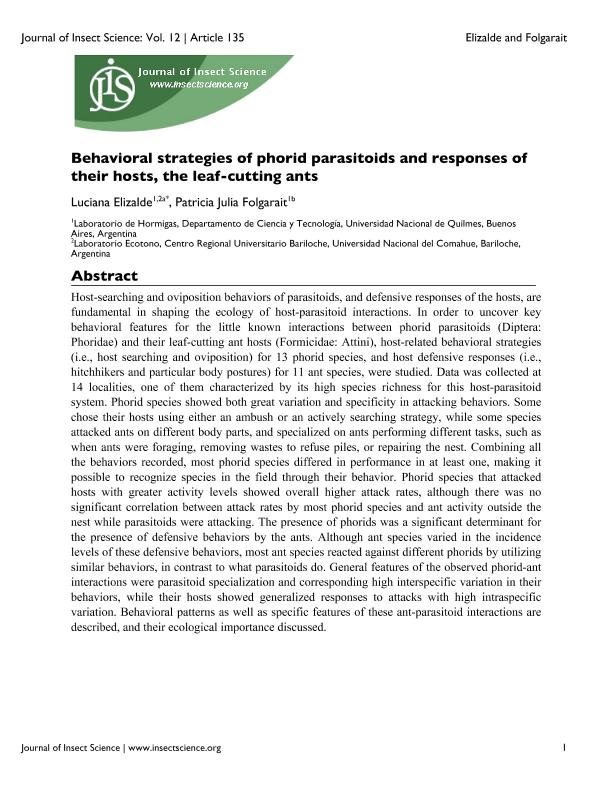Mostrar el registro sencillo del ítem
dc.contributor.author
Elizalde, Luciana

dc.contributor.author
Folgarait, Patricia Julia

dc.date.available
2023-04-28T11:07:37Z
dc.date.issued
2012-06
dc.identifier.citation
Elizalde, Luciana; Folgarait, Patricia Julia; Behavioral strategies of phorid parasitoids and responses of their hosts, the leaf-cutting ants; University of Arizona; Journal of Insect Science; 12; 6-2012; 1-26
dc.identifier.issn
1536-2442
dc.identifier.uri
http://hdl.handle.net/11336/195749
dc.description.abstract
Host-searching and oviposition behaviors of parasitoids, and defensive responses of the hosts, are fundamental in shaping the ecology of host-parasitoid interactions. In order to uncover key behavioral features for the little known interactions between phorid parasitoids (Diptera: Phoridae) and their leaf-cutting ant hosts (Formicidae: Attini), host-related behavioral strategies (i.e., host searching and oviposition) for 13 phorid species, and host defensive responses (i.e., hitchhikers and particular body postures) for 11 ant species, were studied. Data was collected at 14 localities, one of them characterized by its high species richness for this host-parasitoid system. Phorid species showed both great variation and specificity in attacking behaviors. Some chose their hosts using either an ambush or an actively searching strategy, while some species attacked ants on different body parts, and specialized on ants performing different tasks, such as when ants were foraging, removing wastes to refuse piles, or repairing the nest. Combining all the behaviors recorded, most phorid species differed in performance in at least one, making it possible to recognize species in the field through their behavior. Phorid species that attacked hosts with greater activity levels showed overall higher attack rates, although there was no significant correlation between attack rates by most phorid species and ant activity outside the nest while parasitoids were attacking. The presence of phorids was a significant determinant for the presence of defensive behaviors by the ants. Although ant species varied in the incidence levels of these defensive behaviors, most ant species reacted against different phorids by utilizing similar behaviors, in contrast to what parasitoids do. General features of the observed phorid-ant interactions were parasitoid specialization and corresponding high interspecific variation in their behaviors, while their hosts showed generalized responses to attacks with high intraspecific variation. Behavioral patterns as well as specific features of these ant-parasitoid interactions are described, and their ecological importance discussed.
dc.format
application/pdf
dc.language.iso
eng
dc.publisher
University of Arizona

dc.rights
info:eu-repo/semantics/openAccess
dc.rights.uri
https://creativecommons.org/licenses/by-nc-sa/2.5/ar/
dc.subject
host searching
dc.subject
host defense
dc.subject
specialization
dc.subject
generalists
dc.subject.classification
Zoología, Ornitología, Entomología, Etología

dc.subject.classification
Ciencias Biológicas

dc.subject.classification
CIENCIAS NATURALES Y EXACTAS

dc.title
Behavioral strategies of phorid parasitoids and responses of their hosts, the leaf-cutting ants
dc.type
info:eu-repo/semantics/article
dc.type
info:ar-repo/semantics/artículo
dc.type
info:eu-repo/semantics/publishedVersion
dc.date.updated
2023-04-27T13:00:52Z
dc.journal.volume
12
dc.journal.pagination
1-26
dc.journal.pais
Estados Unidos

dc.journal.ciudad
Arizona
dc.description.fil
Fil: Elizalde, Luciana. Universidad Nacional de Quilmes; Argentina. Consejo Nacional de Investigaciones Científicas y Técnicas; Argentina
dc.description.fil
Fil: Folgarait, Patricia Julia. Consejo Nacional de Investigaciones Científicas y Técnicas; Argentina. Universidad Nacional de Quilmes; Argentina
dc.journal.title
Journal of Insect Science

dc.relation.alternativeid
info:eu-repo/semantics/altIdentifier/doi/http://dx.doi.org/10.1673/031.012.13501
dc.relation.alternativeid
info:eu-repo/semantics/altIdentifier/url/https://academic.oup.com/jinsectscience/article/12/1/135/891122
Archivos asociados
